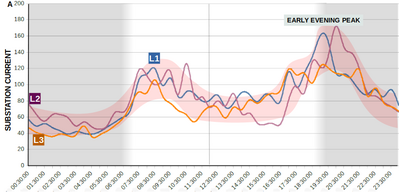Adding battery storage to SolarEdge PV system
Posted by: @transparentHow much can you trust Capture Energy without being able to inspect and check its (confidential) supply and stand-by contracts?
I don't, and in fairness they aren't yet including any income from Grid Flexibility services in their projections of battery payback.
They do however include a significant amount of arbitrage, about twice the income from exporting PV. Basically their calculations assume you fill a 20-30kWh battery at low cost night and discharge it to the grid (in summer), or to your house (in winter), during the day (or the equivalent if you have an agile tarif).
With my current tariff (6.7p (midnight-7am), 25p (7am-mindnigh), and 16.5p export) and use pattern I still cant make the business case work at GBP 400-500/kWh for the storage though, so wont be buying.
4kW peak of solar PV since 2011; EV and a 1930s house which has been partially renovated to improve its efficiency. 7kW Vaillant heat pump.
Posted by: @jamespaI still cant make the business case work at GBP 400-500/kWh for the storage though, so wont be buying.
I think @nazuro1041 needs to note this !
There's a lot of capital outlay to install a storage battery and inverter.
There's no certainty of recouping that through tariffs which could change with less than 6-months notice.
Of course, if you joined in with a Community Energy initiative, and had a share in a 3-phase storage battery asset, then the financial viability could change for the better.
Save energy... recycle electrons!
Posted by: @transparentecondly, there are no Nodal Pricing Tariffs yet available (outside of Community Energy schemes).
The Sec of State for Energy has twice changed his mind on "Zonal Pricing" in the first 6-months of 2025, under pressure from No.10.
Regardless of the underlying technical arguments, politicians are only evaluating the political consequences.
Sadly I fear that they may well be right to do so.
Now that the cross party consensus on net zero has disappeared, and in the current febrile political environment, any policy (particularly a complex one with a highly technical justification) that is even faintly connected to net zero and which is capable of being spun as a 'postcode lottery', or worse still, as 'penalising hard working brits to fund illegal immigrants' risks helping to hand a victory at the next election to those who would undo all the good work that is currently underway towards reducing our carbon emissions.
Nodal pricing presumably introduces sufficient variation across the country that any bent statistician worth his (or her) salt can find an explosive example which does indeed penalise an area with predominantly 'hard working brits' while helping an area with a higher proportion of immigrants. Even if they cant it wouldn't matter, they would just make it up anyway, and on the back of that an exaggerated claim will appear on the front page/as the lead story of certain media outlets
It may well be in the long term interests of the planet to concede such divisive matters at the current time, even if it makes no technical sense.
Its a very sad position that we have reached, but politicians must deal with political reality as well as science/engineering and, however well intentioned and logical they may be, its no use at all if their work is undone in a few years time.
4kW peak of solar PV since 2011; EV and a 1930s house which has been partially renovated to improve its efficiency. 7kW Vaillant heat pump.
@nazuro1041 I am not a grid expert like others, and there are some relevant points that James and Transparent have highlighted already. But, anyway, I will add my thoughts below if that helps.
When we decided to invest in a battery energy storage system, it was primarily to leverage time of use tariffs to store at cheaper EV rates, and use it to offset higher costs later in the day. Even if ToU tariffs didn't last for long, we would have recovered some of the initial outlay, and the emergency backup power option was the added bonus. Later, when we added the solar panels, it meant that we could increase our self sufficiency a little bit more outside the peak summer months by storing excess solar energy in the batteries.
But when we added the heat pump later, the calculations were again in favour of the batteries, as we could use the energy stored to delay importing from the grid for heating. Even if ToU tariffs were to disappear in a few years, the investment should have paid off, as now we are comparing heating with gas vs heating with cheap electricity stored in the early morning hours, for NPV and RoIC calculations. As an ex-banker, returns are one key motivation for any of my capital investments, but with complex and constantly changing situations with energy, I am confident of getting my money back one way or other. We decided to increase the storage further recently, as I realised by adding more storage the batteries will cycle less to increase their life and that way I have more years to recover the initial investment. Having said that with expensive options like Tesla or MyEnergi Libbi (not sure of the prices now), I wasn't sure of getting money back. Hence, I went for Growatt which was like mid-range in pricing.
Charging at cheaper rates and then force exporting later was an option I never considered for my calculations. I couldn't model the impact that would have on battery life with reasonable statistical significance, so I didn't want to calculate my returns based on that option. My preference is to prolong the life of the batteries with a scenario that may pay me less but for longer. Like allocating a part of the investment portfolio to fixed income assets. Less risky but also lower returns. Obviously, the removal of VAT from installations of batteries helps with the returns.
16 * 435 watts PV
13 kWh Growatt battery
1 EV - Mercedes EQB
6 kW Aira Heat Pump
First things first, thanks to Transparent for sanity checking my earlier post. Glad what I said was accurate, even more glad @nazuro1041 is aware now that it doesn't apply to his case.
In all these decisions, I have to say that simple is your friend and that it pays to work the 80:20 rule. I have only a small number of straightforward automations that wring a lot from price fluctuations and times of negative prices as well as the “business as usual” charging from solar and exporting the excess. I’m sure I could benefit further from the kind of activity Transparent has been trying to discourage but in reality I believe the effort and added complexity would not justify that final bit of personal gain. In short, for a small outlay in time and effort, I’m already getting 80-90% of the potential benefits.
I also happen to include carbon intensity into my calcs, so “benefit” to me includes a social responsibility aspect too.
105 m2 bungalow in South East England
Mitsubishi Ecodan 8.5 kW air source heat pump
18 x 360W solar panels
1 x 6 kW GroWatt battery and SPH5000 inverter
1 x Myenergi Zappi
1 x VW ID3
Raised beds for home-grown veg and chickens for eggs
"Semper in excretia; sumus solum profundum variat"
Posted by: @chandykrisMy preference is to prolong the life of the batteries with a scenario that may pay me less but for longer. Like allocating a part of the investment portfolio to fixed income assets.
Yes, I agree with that thinking.
There's one other group who would benefit greatly from having storage batteries: those in social housing.
So I'm going to tag @dgt_73 - David arrived on the Forum earlier this month, and works for a charity who [...] have been upgrading Scotland's housing stock for Net Zero [...]
Those in social housing are much more likely to be on prepayment meters, with energy debts preventing them from switching suppliers.
Not only does that make it more expensive for them to run a heat-pump, but they disproportionately contribute more to the early-evening period of national peak demand.
There's no financial benefit for them to shift electricity use outside of that period.
That's bad news for all of us because they're driving the underlying need for expensive grid upgrades.
However, social housing is often found in clusters.
That makes it attractive for the Landlord to install a sizeable storage battery across all three phases,
and feed each house in an 'off-grid' fashion.
The tenants are effectively moved to a Time-of-Use social tariff, with batteries only replenished from the grid when costs are lower.
The DNO will be in favour because there's no more losses due to phase imbalance at the local substation.
That opens up a possible negotiation for a hefty discount for connecting up the battery enclosure 😊
I can think of several ways in which this can be achieved technically.
So that provides some flexibility for discussions about how the tenants will be charged in future, and by who.
Save energy... recycle electrons!
@transparent Your previous comments on this subject provided food for thought for me whilst trying Intelligent Octopus Flux for about six weeks a while back. For other reasons as well, I reverted to Cosy as I feel that that TOU tariff and my 27 kWh capacity battery would be a little kinder to the grid. (I do intend to write a summary of my findings as previously promised but I am still awaiting correct billing details for the period of IOF use.) Regards, Toodles.
Toodles, heats his home with cold draughts and cooks food with magnets.
@transparent That's a good point. I did watch a recent Modo Energy podcast where they interviewed the founder of an Australian community battery cooperative. I was wondering whether such initiatives exist here at home.
Kudos to David and others who are working towards moving our housing stock to Net Zero.
16 * 435 watts PV
13 kWh Growatt battery
1 EV - Mercedes EQB
6 kW Aira Heat Pump
@toodles Looking forward to reading your summary of the findings. I was wondering whether we should move to Cosy in January, as my consumption model suggests that if I stick to Octopus Go tariff we will tap into the grid in the 4 pm to 7 pm window only that month, albeit cheaper than being on the Cosy tariff. I can always change my inverter settings to use the grid instead from 1 pm to 4 pm but not charge the battery at that time. This would mean our batteries would be enough to feed the house load during the 4 pm to 7 pm window. But, your findings will give me more food for thought.
16 * 435 watts PV
13 kWh Growatt battery
1 EV - Mercedes EQB
6 kW Aira Heat Pump
@chandykris Just briefly for now, I find that having the ‘Cosy’ periods of 3, 3 and 2 hours per 24 hours with sufficient battery capacity, I can cruise through all the other 16 hours of the day in the winter without using any grid power at those higher rates.
Our Daikin ASHP typically consumes ~ 40 kWh on a very cold winter day* and usually rather less is required during milder periods. Naturally, we may have a few kWh’s worth of solar energy to assist but the battery supplies the bulk of the energy required - purely from those nicely spread out 8 Cosy hours. I believe some readers may have a cheaper tariff if an EV sits outside their house but this is not an option here.☹️
* We are in the throes of replacing old double glazing throughout our home with triple glazed units and I’m looking forward to a further reduction in consumption this coming winter. Regards, Toodles.
Toodles, heats his home with cold draughts and cooks food with magnets.
@toodles That aligns with our experience. We do have an EV, and though it's low mileage, the pre-entry climate control to keep the car toasty for 7 am school run does add to the kWh consumption. Having said that, even with a much smaller battery (6.5 kWh Growatt), we managed to stay off the peak grid usage this winter season on the Cosy tariff. The excessive cycling worried me, so I doubled the capacity to 13 kWh.
Our Aira heat pump consumes about 30 kWh on a very cold day, but should average around 23 kWh in January, so staying on Octopus Go would be cheaper, considering EV usage, and running DHW during the 12:30 am to 05:30 am cheaper period. But, we would use most of the 13 kWh battery by 4 pm, if we don't change the inverter settings like I mentioned in my earlier post. I want to do my bit to help the grid, so I could switch to Cosy for January only, or change the inverter settings in January. Never in a million years I would have considered all these scenarios until a year ago. Going a rabbit hole sometimes helps with building the necessary knowledge to take such decisions on a smaller scale, but if a million people take such decisions, that helps with the wider cause. Sorry, rambling again 😂
16 * 435 watts PV
13 kWh Growatt battery
1 EV - Mercedes EQB
6 kW Aira Heat Pump
@chandykris No need to apologise at all! I forgot to add that our ASHP is on 24/7 during the heating months (not the rest of the year as the DHW is a Sunamp Thermino powered from the solar energy most of the time). We do have our system set to 22.5 degrees C everywhere (the bathroom is set higher though) so we might impose a higher demand on the ASHP than many families might.
I have a ‘roaming eye’ when it comes to energy tariffs but haven’t yet seen any scheme that would definitely improve on OE’s Cosy for us. Regards, Toodles.
Toodles, heats his home with cold draughts and cooks food with magnets.
- 26 Forums
- 2,378 Topics
- 53.9 K Posts
- 133 Online
- 6,060 Members
Join Us!
Worth Watching
Latest Posts
-
RE: Grant ASHP 17.5 kw. weather curve
Firstly welcome to the forums. I hope you ar...
By JamesPa , 5 hours ago
-
RE: Solar Power Output – Let’s Compare Generation Figures
@toodles We had a reroof concurrently with the PV in...
By Papahuhu , 6 hours ago
-
RE: Cascade 2x Grant Areona 10kw ASHP - Ongoing setup issues
(Almost) all heat pumps do defrost by taking heat from ...
By JamesPa , 6 hours ago
-

The Great British Heat Pump Owner Persona Survey: Let's Build Our Archetype!
Happy New Year everyone! As we head into 2026, ...
By Mars , 6 hours ago
-
RE: Testing new controls/monitoring for Midea Clone ASHP
Seems to be the only logical explanation. Our ASHP was ...
By benson , 8 hours ago
-
RE: Radiator sizing sanity check
@jamespa thanks, yes it seemed mad to me. An exert f...
By Papahuhu , 8 hours ago
-
RE: Optimum new build house design for Heat Pump
From first principles I would say: Definitel...
By JamesPa , 10 hours ago
-

RE: Weather compensation- why you should use it
As good a place as any to drop this video:/p>
By Mars , 13 hours ago
-
RE: Forum updates, announcements & issues
@transparent D'Oh - I did look before I posted but I mi...
By dr_dongle , 14 hours ago
-
Compatibility with Samsung AE080RXYDEH
I am new to all this. We have a SamsungAE080RXYDEH that...
By John999 , 14 hours ago
-
RE: New Fogstar 15.5kWh upright solution
@batpred Maybe you should buy your additional batter...
By Bash , 16 hours ago
-

RE: Data Accuracy Problem: Daikin 8kW Heat Pump's Onecta App vs MMI Power Consumption
@nursethescreens Yes, comfort and happiness of the fami...
By Toodles , 17 hours ago
-
RE: Connecting Growatt SPH5000 over wired ethernet rather than wireless
Thanks folks. I had tried googling an ethernet lab adap...
By z8lccda , 1 day ago
-
RE: Changing from 4-port buffer to volumizer
@toodles I'm not concerned that the behaviour is not no...
By Andy1618 , 1 day ago
-

-

RE: Setback savings - fact or fiction?
I agree, and I think there are two things in play here....
By cathodeRay , 2 days ago
-
RE: Water Hammer After Heat Pump Install
That's really helpful. Yor last sentence confirms it'...
By JamesPa , 2 days ago
-
RE: Help needed with Grant Aerona 3 issues
First time posting so bear with me. Some bits that have...
By Adamp , 2 days ago
-
RE: Mitsu PUHZ-SW120YHA + EHSC-VM20Uk - Performance
All understood. Obviously its a bit house de...
By JamesPa , 2 days ago





